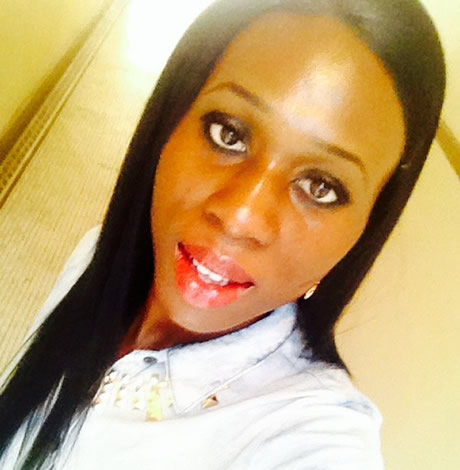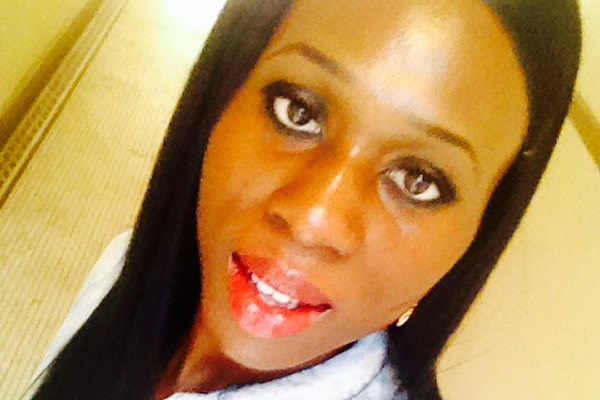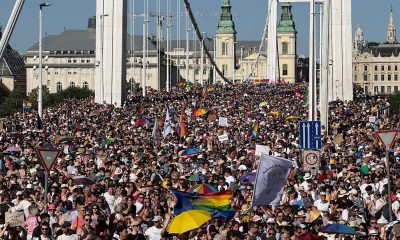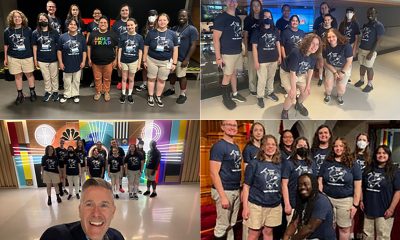Opinions
Alston House, Code for Progress help trans woman thrive
A fresh start after being kicked out of home and school


Casidy Henderson (Photo courtesy of Casidy Henderson)
While we, as a society, have made great progress toward equality for LGBT people, we still have a ways to go. This is particularly evident when engaging with young LGBT people who have been rejected by their families, peers or communities as a result of their sexual orientation or gender identity.
Casidy Henderson, 23, is a transgender District resident who immigrated to the United States from Sierra Leone when she was seven years old. She has been living as a woman for two and a half years and has been on hormones for 10 months. In her young life, she has been repeatedly ostracized and tormented as a result of her sexual orientation and gender identity.
Casidy is a promising young woman who could have easily fallen through the cracks, if not for the support from several nonprofit organizations that work tirelessly to improve lives and ensure that the individuals that they work with leave their programs with the skills to thrive.
The Wanda Alston Foundation, which operates the Wanda Alston House, is one of those programs. (Full disclosure: I serve on the board of the Wanda Alston Foundation.) The Wanda Alston House provides transitional housing to homeless LGBTQ youth. Casidy became homeless after being put out of her Southwest Virginia Christian boarding school due to her sexual orientation. At the time, Casidy was still living as a young man. Due to her mannerisms, she was perceived to be gay and was harassed by the other students.
“Kids would pee on my pillowcase. They would beat me up in the back of the school. People would put bleach in my drinks and call me derogatory names,” Cassidy said. “This happened every day because I ate, slept, went to school and went to church with them. I couldn’t reach out to staff at school because I was gay. They would turn a blind eye when the boys beat me up or dragged me down the staircase.” Cassidy says she was eventually asked to leave the school because her Facebook status said that she was gay.
“I had to explain the situation to my family of why I was kicked out and that I was gay. It was obvious because I was effeminate, but it was the first time I said it,” she said. Her family had never been supportive of her sexual orientation and, throughout her childhood, some of her relatives were verbally and physically abusive. The boarding school gave Casidy a one-way bus ticket to D.C., where she stayed with her uncle for four months. After he put her out, she stayed with friends for a few more months. She found out about the Wanda Alston House from a Transgender Health Empowerment employee who was handing out fliers and condoms outside of the Safeway on Benning Road, N.E.
“I found out about the Wanda Alston House, filled out an application, and moved in three days later,” Casidy said. She stayed at the Wanda Alston House for 18 months. The house operates as a home with a curfew, rules and chores. “I was free to be myself. I had other peers who were trans. The whole LGBT community was in the house. It’s really not a shelter. It’s a three-story house with a deck. We had a therapist who came in once a week. We would discuss issues and problems. We were a team. That really helped me. It nurtured me spiritually, mentally, physically and emotionally. Being in the house was a place for me to heal myself. Being in that safe place was everything for me. I never before had issues that could be addressed and had a whole team work on it.”
While in the house, Cassidy received her GED and scored 200 points shy of a perfect score. After leaving the house, she found an apartment and, simultaneously, worked as a housekeeper in a hotel and as an intern with the Children and Youth Investment Trust Corporation (CYITC) summer initiative.
Her work with CYITC gave her experience in advocacy and social justice, which is why she jumped at the opportunity to become a fellow with Code for Progress, whose goal is to “train and support new coders who can bring historically under-represented perspectives to the tech industry.”
In April, Casidy was one of 12 people who began the one-year program. According to program descriptions, the “curriculum will focus on contemporary coding techniques, human-centered database programming and application development” for 40 hours a week during the 16-week training residency. The program includes mentorship, a stipend, and post graduation career support.
“When I heard about Code for Progress, I was like, I know how to advocate for justice, but I was lacking the technical skills. Now I can program computers, develop apps, create websites, create databases and set them up. I’m empowered now and it’s only been a month that I’ve learned these things. We have an awesome professor. She simplifies things and brings so much to the table.”
As part of the fellowship, Casidy wants to create an app that will aggregate all available LGBT resources within a community. “I’m well informed about different issues and Code for Progress is giving me a vital piece of the puzzle to make me a resource for my community,” she said. “If all these agencies are speaking as one huge body and sharing info, change is going to happen. If this app is successful, I want to expand it to different cities.”
Lateefah Williams’ biweekly column, ‘Life in the Intersection,’ focuses on the intersection of race, gender and sexual orientation. She is a former president of the Gertrude Stein Democratic Club. Reach her at [email protected] or follow her @lateefahwms.
Opinions
Community comes together to repair WorldPride history exhibition
Vandals damaged pictures, timeline walls on June 22

Earlier this month, vandals shouting homophobic slurs damaged the 8-foot hero cubes and timeline walls of the Rainbow History Project’s (RHP) WorldPride exhibition “Pickets, Protests, and Parades: The History of Gay Pride in Washington.” The week’s incident was the fifth homophobic attack on the exhibition chronicling DC’s LGBTQ+ History, the vandalism damage was only made worse by the storms this past week.
In response, RHP posted a call online for volunteers and donations and over a dozen volunteers showed up on Saturday to repair the exhibition in its final stretch.
It took three hours, but the group assembled during a heat advisory to bend the fences back into place, fix the cubes and zip tie all the materials together to keep them safe. Some of those who came out to volunteer, Slatt said, were known RHP volunteers but most were total strangers who had attended an event here or there or just wanted to get involved for the first time, one was even in D.C. as an out-of-town guest and after seeing the Instagram call, decided to spend their day lifting some heavy fencing back into place.
When asked why they showed up, volunteer Abbey said: “especially during Pride month, it’s so important to come together as a community, not just to celebrate, but to support each other. To know that this historic exhibit is even able to exist right now under this administration is really amazing. The fact that we’re just able to help continue it in its last leg of being out here is really important.”
“Rainbow History Project does a lot of work for the community,” another volunteer Ellie said, “they show up in a lot of ways that I think we really need right now, so in terms of being asked to come out and do a couple hours of lifting, that is something that we can easily support and do.”
“We put out a call asking for support from the community, and so we didn’t know what we’d get,” Slatt continued, “but strangers have shown up. We were upset, we were crying. We were trying to come up with a battle plan and more and more people have shown up with open arms and empty hands to do this. It’s 95 degrees, we are melting in the heat. It’s just amazing the number of people who have come here.”
If anything, the anonymous exhibit designer said, the people who vandalized the exhibit made the community stronger and mobilized members passionate about preserving and sharing our histories. Their efforts backfired in a big way — bringing together people who had only attended one or two RHP events or had read about the organization online to actively contribute to the work.
It’s a meaningful representation of the history of D.C.’s LGBTQ+ community, one that often starts with a small group of people who come together to protest but soon mobilize their communities and enact monumental change in the nation’s capital.
“If Pride in D.C. started with 10 people picketing the White House,” Slatt remarked, “you just got 12 more to join the gay history movement.”
This was especially poignant, another volunteer Mattie said, on the week that the Supreme Court issued a decision allowing Tennessee to ban puberty blockers and hormone therapy for minors seeking gender affirming care. It was a devastating moment for the LGBTQ+ community who mobilized once more in front of the Supreme Court this past Friday.
“It’s been actually really important to see this community come together in the face of direct attack on our history in the wake of direct attacks on our rights,” Mattie said, “and we stand up to that. We come together, and we represent. That is so important to maintaining our strength and our community throughout trying times now and ahead.”
When asked about how community members can support RHP’s work and repair the damage long-term to the exhibit, Slatt urged people to donate to RHP, to volunteer as exhibit monitors, and to come visit the exhibit.
“We’ve been doing this for 25 years. This is our 25th anniversary, and if it weren’t for volunteers donating their time and their talents, if it weren’t for small dollar donors, we would never have gotten anything done,” Slatt said. “I’d say to anyone out there that we are on this plaza all through Independence weekend, we are here through the Smithsonian Folklife Festival, people can come on down.”
Slatt and other volunteers will be leading tours each evening at 7 p.m. at Freedom Plaza, and people can pre-order the exhibition catalog right now, which will be delivered in time for LGBTQ+ History Month in October.
Emma Cieslik is a D.C.-based museum worker and public historian.

Independence Day, commonly known as the Fourth of July, is a federal holiday commemorating the ratification of the Declaration of Independence by the Second Continental Congress on July 4, 1776, establishing the United States of America. The delegates of the Second Continental Congress declared the 13 colonies are no longer subject (and subordinate) to the monarch of Britain, King George III and were now united, free, and independent states. The Congress voted to approve independence by passing the Lee resolution on July 2, and adopted the Declaration of Independence two days later, on July 4.
Today we have a felon in the White House, who wants to be a king, and doesn’t know what the Declaration of Independence means. Each day we see more erosion of what our country has fought to stand for over the years. We began with a country run by white men, where slavery was accepted, and where women weren’t included in our constitution, or allowed to vote. We have come far, and next year will celebrate 250 years. Slowly, but surely, we have moved forward. That is until Nov. 5, 2024, when the nation elected the felon who now sits in the Oval Office.
There are some who say they didn’t know what he would do when they voted for him. They are the ones who were either fooled, believing his lies, or just weren’t smart enough to read the blueprint which laid out what he would do, Project 2025. It is there for everyone to see. There should be no surprise at what he is doing to the country, and the world. Last Friday his Supreme Court, and yes, it is his, the three people he had confirmed in his first term, gave him permission to be the king he wants to be. The kind of king our Declaration of Independence said we were renouncing. A man who with the stroke of a pen can ruin thousands of lives, and change the course of America’s future. A man who has set back our country by decades, in just a few months.
So, I understand why many are suggesting there is nothing to celebrate this Fourth of July. How do we have parties, and fireworks, celebrating the 249th year of our independence when so many are being sidelined and harmed by the felon and his MAGA sycophants in the Congress, and on the Supreme Court. Yes, there are those celebrating all he is doing. Those who want to pretend transgender people don’t exist, and put their lives in danger; those who think it’s alright to take away a women’s right to control her body, and her healthcare; those who think parents should be able to interfere on a daily basis with their children’s schooling and wipe out the existence of gay people for them. Those who pretend there was a mandate in the last election, when it was only won by about 1 percent. Those who think disparaging veterans, firing them, and taking away their healthcare, is ok. Those in the LGBTQ community like Log Cabin Republicans, who think supporting a racist, sexist, homophobe is the right thing to do.
So, what do we, as decent caring people, do this Fourth of July. What do we say to those who are being harmed as we celebrate. What do we say to those trans people, those women, those immigrants who came here to escape their own dictators, and are now finding they have come to a country with its own would-be dictator. I say to them, please don’t give up on America. Don’t give up on the possibility decent loving people in our country will finally wake up and say, “enough.” That the majority of Americans will remember we fought a revolution to escape a king, and we fought a civil war to end slavery. That we moved forward and gave women the right to vote, and gave the LGBTQ community the right to marry. Don’t give up on the people that did all that, and think they won’t rise up again, and tell the felon, racist, homophobe, misogynist, found liable for sexual assault, now in the White House, and his sycophants in congress, and his cult, that we will take back our country in the 2026 midterm elections. That we will vote in large numbers, and demand our freedom from the tyranny that he is foisting on our country.
So yes, I will celebrate this Fourth of July not for what is happening in our country today, but rather for what our country actually stands for. Not for birthday parades, and abandonment of the heroes in Ukraine in support of dictators like Putin. But for the belief the decent people in our country will rise up and vote. That is what I will celebrate and pray for this Fourth of July. That is what I think the fireworks will mean this July Fourth. I refuse to accept defeat the same way our revolutionary soldiers wouldn’t, and the way our troops in the civil war wouldn’t till the confederacy was defeated.
I will celebrate this Fourth of July because I refuse to accept we will not defeat those who would destroy our beautiful country, and what it really stands for.
Peter Rosenstein is a longtime LGBTQ rights and Democratic Party activist.
Opinions
Is it time for DC to have new congressional representation?
Del. Eleanor Holmes Norton will turn 89 in June

With WorldPride, Supreme Court decisions, military parades in our streets, mayor and City Council discussions about a new football stadium, it is entirely understandable if we missed the real local political story for our future in the halls of Congress. Starting this past May, the whispered longtime discussions about the city’s representation in Congress broke out. Stories in Mother Jones, Reddit, Politico, Axios, NBC News, the New York Times, and even the Washington Post have raised the question of time for a change after so many years. A little background for those who may not be longtime residents is definitely necessary.
Since the passage of the 1973 District of Columbia Home Rule Act, we District residents have had only two people represent us in Congress, Walter Fauntroy and Eleanor Holmes Norton, who was first elected in 1990 after Mr. Fauntroy decided to run for mayor of our nation’s capital city.
No one can deny Mrs. Norton’s love and devotion for the District. Without the right to vote for legislation except in committee, she has labored hard and often times very loud to protect us from congressional interference and has successfully passed District of Columbia statehood twice in the House of Representatives, only to see the efforts fail in the U.S. Senate where our representation is nonexistent.
However, the question must be asked: Is it time for a new person to accept the challenges of working with fellow Democrats and even with Republicans who look for any opportunity to harm our city? Let us remember that the GOP House stripped away millions of OUR dollars from the D.C. budget, trashed needle exchange programs, attacked reproductive freedoms, interfered with our gun laws at a moment’s notice, and recently have even proposed returning the District to Maryland, which does not want us, or simply abolishing the mayor and City Council and returning to the old days of three commissioners or the very silly proposal to change the name of our Metro system to honor you know you.
Mrs. Norton will be 89 years old next year around the time of the June 2026 primary and advising us she is running for another two-year term. Besides her position there will be other major elected city positions to vote for, namely mayor, several City Council members and Board of Education, the district attorney and the ANC. Voting for a change must not be taken as an insult to her. It should be raised and praised as an immense thank you from our LGBTQ+ community to Mrs. Norton for her many years of service not only as our voice in Congress but must include her chairing the Equal Employment Opportunity Commission, her time at the ACLU, teaching constitutional law at Georgetown University Law School, and her role in the 1963 March on Washington.
Personally, I am hoping she will accept all the accolades which will come her way. Her service can continue by becoming the mentor/tutor to her replacement. It is time!
John Klenert is a longtime D.C. resident and member of the DC Vote and LGBTQ+ Victory Fund Campaign boards of directors.
-

 Hungary4 days ago
Hungary4 days agoUpwards of 100K people march in Budapest Pride
-

 U.S. Supreme Court5 hours ago
U.S. Supreme Court5 hours agoSupreme Court to consider bans on trans athletes in school sports
-

 Theater5 days ago
Theater5 days ago‘Andy Warhol in Iran’ a charming look at intersection of art, politics
-

 Opinions5 days ago
Opinions5 days agoPragmatic presidents invest in America











